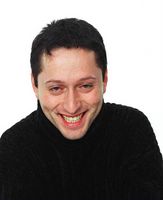2.08.2005
The boy with kaleidoscope eyes.

The following is an excerpt from the MoMA P.S.1 website about Ashkan Sahihi's portraiture series entitled: The Drug Series. Above is one of the subjects, the one that Sahihi stated in an interview with Vice magazine, " . . . got the most high and seemed to have the most fun." He was on mescaline.
The eleven cibachrome prints in The Drug Series—Crack, Cocaine, Heroin, Marijauna, LSD, Psilocybin, Ketamine, Ectasy, Amphetamine, Hashish, and Mescaline—depict a cross-cultural sample of adults ranging in age from 24-28 years who had little or no prior experience with drugs. During the sessions, only the artist, the volunteer, the volunteer’s choice of companion, and a nurse were allowed in the studio. After signing releases, the volunteers took a dose of their designated drug and waited for the chemical to take hold. This "clinical" approach was motivated in part by Sahihi’s desire to see how the traditional relationship between a photographer and his subject is changed, when a third party, such as a hallucinogenic drug, asserts its own force. For each drug/subject cycle in The Drug Series, Sahihi then selected the one image that he felt best represented the volunteer’s experience on the particular drug he or she ingested. The resulting images of the anonymous subjects suggest the unpredictability of a drug’s force; some people smile or laugh, others appear pensive and detached, another is disoriented, unreachable.
Sahihi’s attempt to control the experience underscores the specificity of an individual’s reaction based on variables such as body weight, gender or mental history. However, the portraits make manifest a general reality of drug use that often remains unseen. In Sahihi’s white-walled, brightly-lit studio, the photographs become a visual record of the physiological effects of drug use—blotchy skin, bloodshot eyes and dilated pupils—that often go undetected at night. By attempting to present an objective image of drug use, the artist addresses the cultural politics that allow our society to simultaneously glamorize the "drug look" in fashion magazines and the entertainment industry, and meanwhile, turn a blind eye to the complicated, and vast, problem of drug abuse.
Miss Hag. has long supported recreational drug use. However, this weekend, she has been dealing with the possibility of one of her chosen family members entering a treatment program of some sort. It has not been a pretty journey, particularly since Miss Hag. is not what one could describe as "clean and sober." She is afraid her enabler will have lost her drinking buddy.
It leads me to think of people I have known who have gone through "The Program" as AA is often referred. Many seem to work well within the boundaries of the twelve steps. But, for many, the program will sometimes replace one addiction with another: addiction to the program.
Augusten Burroughs writes about his experience in rehab in his memoir, Dry. There is a moment early on when Burroughs writes about hoping rehab will teach him how to drink like a normal person. It has stayed with me because I believe that this is not as ridiculous as it may seem to sound. There has to be a way to teach moderation. "Just say No," the War on Drugs and "Wait till you're 21" have not been realistic or successful.
Certainly, there are people whose biology will not allow a puff of a joint or a bump of cocaine. But, that is not necessarily true for all people. Some of the best writing I have created has been while I have been stoned. But, in general, most people do not seem to know how to moderate. I have too much experience interacting with people who have reached a point in intoxication that is not amusing or fun. I fear this point has been reached within even my closest circle of friends. How do we start drinking (or smoking or snorting, what have you) for the right reasons?
"This session scared me completely. She never barfed and just sat there for a really long time scratching her face. She seemed incredibly bored, uncreative, unemotional and numb," Ashkan Sahihi. Heroin.


link * Miss Marisol posted at 7:37 PM *
posted by Miss Marisol @ 7:37 PM
|















